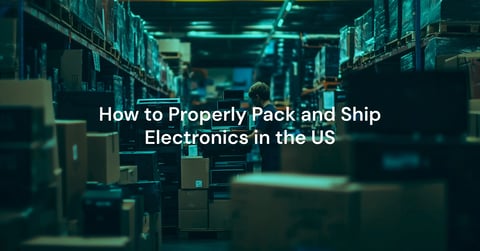How to Properly Pack and Ship Electronics in the U.S.

Online stores sell more electronics each day, with this industry expected to reach US$628.8 billion in revenue by 2030. To capitalize on this growth, retailers need modern fulfillment strategies.
Let’s review the best practices for packing and shipping electronics within the U.S., ensuring optimal delivery speed without compromising the delicate integrity of these valuable products.
Key highlights:
- Optimized electronics delivery relies on a structured process, from strategic carrier selection to precise shipment tracking, minimizing risk and maximizing performance.
- Protect your valuable electronics and control shipping costs with proper packaging. Custom-sized boxes and lightweight infills are essential for preventing damage and avoiding costly dimensional weight charges.
- Requirements for shipping electronics vary per carrier. USPS, UPS, and FedEx each have strict compliance rules for tech devices, particularly those including lithium batteries.
- Shipium optimizes electronics shipping at scale with real-time tracking data, automated carrier selection, and smart cartonization choices.
Best practices for packing electronics
Customers want a fast, damage-free electronics delivery experience. According to The Future Shopper Report, they expect orders to arrive in just 1.85 days, and 56% say they will not shop again with retailers that don’t match expectations. That level of service requires careful packaging — nothing ruins a new phone experience more quickly than a harmed product.
Here are four best practices for packing electronics that enterprise logistics leaders should consider:
1. Invest in custom packaging tailored to your products’ dimensions
A standard-size electronics shipping box often leaves too much empty space, increasing the risk of damage and inflating dimensional weight charges. Enterprise operations benefit from custom packaging solutions that snugly fit each SKU, reducing void-fill requirements and improving product protection.
2. Use lightweight but protective infill materials
Choose infill materials that cushion electronics without adding unnecessary weight — such as molded pulp trays, air pillows, or engineered foam. These materials protect sensitive components during transit while helping minimize shipping costs. Evaluate materials for shock absorption and sustainability to align with both performance and ESG goals.
3. Ensure accurate and visible labeling in your electronics shipping box
Clear, standardized labeling ensures your carrier network and internal team rapidly identify fragile or high-value shipments. As a best practice, add “fragile” and “handle with care” indicators in the electronics shipping box for handling purposes.
Also, account for HAZMAT compliance when labeling and shipping electronics that contain lithium-ion batteries, such as laptops, smartphones, and tablets. These batteries are classified as hazardous materials, so not following regulations can lead to serious incidents that endanger logistics workers and disrupt the supply chain.

If your ecommerce is shipping thousands of lithium-powered electronics per day, automating label generation can minimize manual error and speed up fulfillment. For high-volume operations, automation also increases efficiency across fulfillment centers, guaranteeing label standardization.
Increase enterprise throughput with batch label generation.
4. Leverage real-time data to improve your logistics operation
Use feedback loops to identify damage patterns, missed SLAs, or packaging weaknesses. Check, for example, reasons for customer returns, warehouse exception reports, and delivery tracking data. Monitoring this information helps you:
- Understand which SKUs are more prone to breakage
- Pinpoint which fulfillment centers have higher error rates
- Review which packaging sizes and options trigger surcharges
Getting your packaging strategies right reduces shipping costs early in the fulfillment process, especially when you factor in dimensional weight charges and the ripple effects of oversized packaging.
However, making those decisions at scale is a complex task. A modern enterprise shipping platform like Shipium can help. Our technology helps retailers at every stage of the delivery process, including recommendations for cost-effective packaging for each order.
See how Shipium’s Package Planner API helps you optimize your cartonization strategy.
How to ship electronics: A 5-step guide
Shipping electronics, from high-value smartphones to sensitive computing equipment, requires a careful strategy because they are vulnerable to damage and theft.
Here’s how to ship electronics in the U.S.:
1. Select carriers strategically
Relying on a single provider to ship electronics limits your ability to adapt when volumes spike or ecommerce shipping delays hit. A diversified carrier mix allows you to align service levels with product value and delivery urgency — for example, using premium carriers for high-value items and regional carriers for lower-cost deliveries.
Platforms like Shipium can automate carrier selection based on real-time performance and cost efficiency. Adding a new carrier with us only takes a day instead of months, which is the time that many traditional solutions still take.
2. Choose the right shipping insurance coverage
Since electronics are generally expensive, shipping insurance is recommended. Carriers offer declared value coverage, but it may not fully cover the actual retail cost or include protection for all types of loss or damage. Third-party insurance provides better terms and broader protection when shipping electronics. Set consistent insurance thresholds by product type to control risk and protect margins.
3. Track your electronics shipments
Real-time parcel tracking helps your team respond to delivery exceptions before they become costly problems, such as missed delivery windows, lost high-value items, or chargebacks from late shipments.
Implement a shipment tracking API that integrates with your existing platforms and provides status updates to flag delayed or stalled cargo, streamlining your electronics delivery process.
4. Optimize last-mile delivery
Last-mile delivery is often where many parcel issues arise — either from theft, misdelivery, or customer dissatisfaction.
To reduce risk, offer different options for customers to collect packages, such as scheduled time windows or pick-up points in lockers or retail stores. These alternatives minimize missed deliveries and package loss. An optimized last-mile approach improves both customer satisfaction and overall delivery efficiency.
5. Create a returns process built for electronics
According to the Consumer Returns in the Retail Industry report by NRF, the average retail return rate hit 16.9% in 2024. In the case of electronics, common reasons for returns include product defects or compatibility issues.
A well-designed process for these situations should minimize friction while protecting item value. To increase customers’ likelihood of buying again at your online store, offer box-free, label-free returns and immediate refunds.
How long does it take to deliver electronics?
The total amount of time required to deliver electronics depends on the chosen shipping method, carrier, origin and destination zones, and whether you’re sending parcels domestically or internationally.
Standard ground shipping typically takes one to seven business days within the U.S., while expedited services like 2-day or overnight delivery are available at a higher cost.
Explore ecommerce shipping options you should consider.
How much does it cost to deliver electronics?
The costs for shipping and delivering electronics vary based on package dimensions, weight, insurance, delivery speed, and any added fees for handling hazardous materials.
Electronics often require special packaging materials and insurance, so they can cost more to ship than other retail goods. For flat-rate and more predictable pricing, services like FedEx One Rate offer a budget-friendly alternative, which is useful when shipping laptops or tablets within standard-sized packaging, for example.
Choosing the right carrier for electronics shipping
Each carrier provider offers unique compliance requirements. Let’s break down what you need to know to ship electronics with each major U.S. carrier.
USPS for shipping electronics
USPS is a cost-effective choice for shipping smaller electronics, but it comes with restrictions — for example, devices containing lithium batteries must ship via ground services only and require specific labeling such as “Restricted Electronic Device” and “Surface Transportation Only.”
UPS for shipping electronics
UPS provides guidelines for shipping electronics through their services. For example, when shipping laptops, UPS recommends:
- Powering off the device and avoiding battery removal
- Protecting buttons with cardboard or tape
- Adding foam or bubble wrap to fill any remaining space
- Using a padded box and securing internal packaging to prevent movement
- The carrier also covers how to ship batteries on its website
FedEx for shipping electronics
FedEx offers detailed guidelines for devices like phones and monitors. For example, for smartphones, they instruct to:
- Back up and wipe data
- Use correctly sized boxes
- Wrap devices with protective padding
- Follow battery handling precautions
- Consider adding shipment insurance
FedEx does not allow air shipping of damaged or recalled batteries. However, a free battery shipping guide is available to help you choose the right service based on battery type and weight.
Implement an enterprise solution for shipping electronics
Legacy systems make it difficult for enterprise teams to adapt quickly, especially when shipping sensitive, high-value products like electronics. These platforms feature rigid carrier integrations and slow configuration cycles that limit your ability to respond to volatile demand, regulatory shifts, and last-minute routing changes.
Shipium replaces fragmented, inflexible shipping tech with a modern, cloud-based fulfillment solution that offers:
- Full control and configurability: Manage packaging rules, carrier logic, and fulfillment workflows in-house with our Universal Rules Engine
- Built-in carrier flexibility: Add a new carrier in a day instead of relying on traditional solutions that can take months for that
- ML-powered time-in-transit modeling: Make accurate delivery promises without risking customer satisfaction through an ML-based model
Request a demo to see how Shipium can help you ship electronics confidently.
Frequently asked questions about shipping electronics
Can you ship electronics internationally?
Yes, you can ship electronics internationally, but doing so requires compliance with export laws, customs declarations, and carrier-specific requirements. Sensitive items — particularly those with lithium-ion batteries — may face restrictions or require a dangerous goods declaration. You'll also need to calculate duties, taxes, and delivery timelines based on destination.
What are the most common ways electronics get damaged during shipping?
Electronics get damaged during shipping with:
- Humidity: Excess moisture in the air can lead to condensation inside packaging, potentially damaging sensitive components, especially in high-humidity environments.
- Temperature: Fluctuations in temperature, whether extreme heat or cold, can harm electronics. Cold conditions, in particular, may degrade hard drive performance and shorten battery life.
- Vibration: Continuous vibrations from transport can result in cumulative shock damage that disrupts device functionality.
- Electrostatic Discharge (ESD): Static electricity can build up during transit and discharge into electronic components, damaging delicate circuitry.
- Impacts: Some electronics are as vulnerable as glass to physical shocks. Sudden drops or collisions during transit can crack components or render devices inoperable.
What are the best packaging materials for shipping fragile electronic products?
The best packaging materials for fragile electronics include:
- Corrugated cardboard boxes: Known for their durability and shock resistance, corrugated boxes offer sturdy outer protection and cushioning against impacts.
- Polystyrene foam (styrofoam): This lightweight, rigid material forms a protective buffer around electronics inside the box, absorbing vibration shocks.
- Air-filled options: Bubble wrap inflatable bags add a flexible layer of defense against pressure and sudden jolts.
- Kraft paper: This material keeps electronics from shifting during shipment and offers a more sustainable alternative to synthetic fillers.
- Cardboard corner protectors: These reinforcements are designed to shield the most impact-prone areas of a package — its corners — helping prevent damage from drops or rough handling.
- Packing tape: A strong, industrial-grade adhesive tape ensures the shipping box stays sealed throughout the journey.
How do you save on electronic shipping costs?
Reducing the cost of shipping electronics starts with smart logistics planning. Follow these three proven strategies:
- Consolidate shipments: Group multiple orders into a single shipment whenever possible to reduce the number of packages and lower per-unit shipping costs.
- Leverage carrier discounts: Negotiate carrier rates and ask for volume-based discounts.
- Right-size your packaging: Use the smallest, most efficient packaging that still protects the product.
What is the best way to ship a laptop computer?
The best way to ship a laptop computer is in its original packaging or a custom-fit box with strong internal cushioning. Laptops are both fragile and high-value, so double boxing is recommended for added protection. Include a layer of foam, bubble wrap, or molded pulp trays to keep the device immobilized during transit.
From a logistics perspective:
- Use a sturdy, corrugated box rated for heavy or fragile items.
- Insure the shipment based on the full retail value.
- Choose a tracked shipping method with a signature confirmation.
- If the battery is non-removable, then label the package as containing lithium-ion batteries in compliance with shipping regulations.
Can you mail batteries through the U.S. Postal Service (USPS)?
Yes, you can mail batteries through the U.S. Postal Service (USPS), but there are strict regulations and limitations. Shippers must keep batteries in the device or pack them properly to prevent short circuits. Loose batteries are typically restricted or prohibited, especially for air shipments.
Failure to comply with the USPS norms can result in rejected shipments or legal penalties, so it's critical for enterprise operators to follow USPS HAZMAT guidelines closely.

Diagonal thinker who enjoys hard problems of any variety. Currently employee #5 and the first business hire at Shipium, a Seattle startup founded by Amazon and Zulily vets to help ecommerce companies modernize their supply chains. Previously was CMO at Datica where I helped healthcare developers use the cloud. Prior to that I came up through product and engineering roles. In total, 18 years of experience leading marketing, product, sales, design, operations, and engineering initiatives within cloud-based technology companies.

